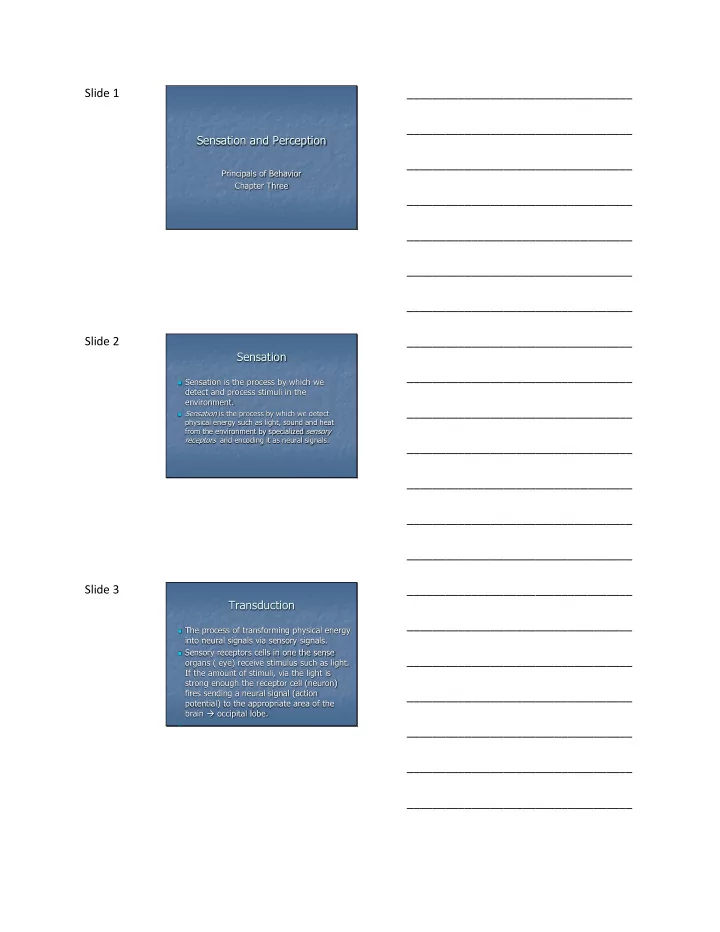

Slide 1 ___________________________________ ___________________________________ Sensation and Perception ___________________________________ Principals of Behavior Chapter Three ___________________________________ ___________________________________ ___________________________________ ___________________________________ Slide 2 ___________________________________ Sensation ___________________________________ Sensation is the process by which we detect and process stimuli in the environment. ___________________________________ Sensation is the process by which we detect physical energy such as light, sound and heat from the environment by specialized sensory receptors and encoding it as neural signals. ___________________________________ ___________________________________ ___________________________________ ___________________________________ Slide 3 ___________________________________ Transduction ___________________________________ The process of transforming physical energy into neural signals via sensory signals. Sensory receptors cells in one the sense ___________________________________ organs ( eye) receive stimulus such as light. If the amount of stimuli, via the light is strong enough the receptor cell (neuron) fires sending a neural signal (action ___________________________________ potential) to the appropriate area of the brain occipital lobe. ___________________________________ ___________________________________ ___________________________________
Slide 4 ___________________________________ Psychophysics The field that studies links between the ___________________________________ physical properties of stimuli and a person’s experience of them. Thresholds- as we are constantly bombarded with ___________________________________ energy,( x-rays, radio waves, ultraviolet and infrared light) Our senses allow only a restricted awareness of this energy as in what stimuli we can detect. ___________________________________ This “restricted awareness” are called thresholds, and they are different for each sensory system. ___________________________________ ___________________________________ ___________________________________ Slide 5 ___________________________________ Sensory Thresholds ___________________________________ Absolute threshold Difference threshold ___________________________________ Just noticeable Difference ___________________________________ Subliminal Perception ___________________________________ ___________________________________ ___________________________________ Slide 6 ___________________________________ The Visual System ___________________________________ Properties of Light Energy is the form of light wave Brightness-amplitude of the wave ___________________________________ Saturation-purity of the wave (presence of more than one wave is less pure or saturated) Color-length of the wave. ___________________________________ ___________________________________ ___________________________________ ___________________________________
Slide 7 ___________________________________ The Structure of the Eye ___________________________________ Cornea -transparent protector through which light enters the eye. Curved surface bends the light to focus at the back of th eye Pupil -a small adjustable opening that regulates the amount of light that enters the eye through a colored muscle called the iris. Lens -transparent structure behind the pupil that also focuses The ___________________________________ cornea does most of the bending, while the lens fine tunes the focus in process called accommodation. accommodation – affects acuity which is the sharpness of our vision, which can be affected by small distortions in the shape of the eye. The shape of the eye influences the focus of the image on the ___________________________________ retina. ___________________________________ ___________________________________ ___________________________________ Slide 8 ___________________________________ ___________________________________ ___________________________________ ___________________________________ ___________________________________ ___________________________________ ___________________________________ Slide 9 ___________________________________ ___________________________________ ___________________________________ ___________________________________ ___________________________________ ___________________________________ ___________________________________
Slide 10 ___________________________________ ___________________________________ ___________________________________ ___________________________________ ___________________________________ ___________________________________ ___________________________________ Slide 11 ___________________________________ Accommodation ___________________________________ Farsightedness- lens is longer and flatter than normal and therefore unable to bring close objects into focus. Focusing the image behind the retina ___________________________________ Nearsightedness- - eyeball is shorter than normal, causing focus to later than normal and therefore objects up ___________________________________ close appear blurred. Focusing the image in front of the retina. ___________________________________ ___________________________________ ___________________________________ Slide 12 ___________________________________ Parts of the Eye ___________________________________ Retina- the light sensitive outer surface of the eye, containing the receptors that begin visual processing receptor cells - located at the back of the retina and converts light into a neural signal Two types of receptor cells, rods and cones. ___________________________________ rods - located around the outside of the retina, responsible for black, white & gray vision, vision in dim light, and peripheral vision. cones -located near the fovea, which was the central focal point in the retina, which is ___________________________________ responsible for color, fine detail and vision in day light. ___________________________________ ___________________________________ ___________________________________
Slide 13 ___________________________________ Photoreceptors ___________________________________ Receptor Cells (Rods & Cones) ___________________________________ Bipolar Cells Ganglion Cells ___________________________________ Optic Nerve ( axons of Bipolar cells) ___________________________________ ___________________________________ ___________________________________ Slide 14 ___________________________________ How the Eye Works Blind spot -is the point at which the optic ___________________________________ nerve leaves the eye and is called the blind spot because there are no receptors there . Optic nerve- the bundle of axons that ___________________________________ carries neural messages from each eye to the brain. Optic chiasm -point near the base of the brain where some, not all of the ___________________________________ optic nerve fibers split and cross to the other side of the brain. ___________________________________ ___________________________________ ___________________________________ Slide 15 ___________________________________ Hemispheric projection:Visual fields ___________________________________ ___________________________________ ___________________________________ ___________________________________ ___________________________________ ___________________________________
Slide 16 ___________________________________ Theories of Color Perception Trichromatic Theory ___________________________________ Proposed three types of cones: red, blue, green Different shades of color correspond to different amounts of light received by each of these three types of cones. ___________________________________ Cones fire message to the occipital lobe Combination of which cones are firing as well as the rate of firing that determines the color ___________________________________ perceived. Problem: After image ___________________________________ ___________________________________ ___________________________________ Slide 17 Stare at the cross in center of the ___________________________________ flag for 30 seconds, now stare at white wall or piece of paper ___________________________________ ___________________________________ ___________________________________ ___________________________________ ___________________________________ ___________________________________ Slide 18 ___________________________________ Theories of Color Perception: Opponent Process ___________________________________ Four primary colors: red, green, blue, yellow Cones are arranged in pairs, red with green, blue with yellow If one memory of the pair is stimulated, i.e. red, ___________________________________ the other member of the pair is turned off, i.e. green. Afterimage-if a person stares at a red object too ___________________________________ long, it weakens that members ability to inhibit the other cell. So, if staring at a red image for too long, one might begin to see green as an after-image. ___________________________________ ___________________________________ ___________________________________
Recommend
More recommend